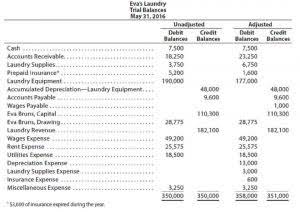Content

For example, no matter the type of product you sell, you could add brands you don’t carry to the negative keyword list. Just keep in mind that you may not want to exclude keywords for brands you do not carry if you have successfully converted people with other brand loyalties in the past.
- Identifying expenditures and keeping track of them gives a business its primary direction regarding income generation and profit margin calculation.
- You can have discussions with your marketing team regarding these non-profitable campaigns.
- It includes direct labor costs and manufacturing overhead costs, but not the cost of direct materials.
- You will have to pay a currency conversion cost to convert back to sterling.
- Ideally, you want to use figures from a wider period of time.
- Organizations should also calculate prime costs, in addition to conversion costs, to understand the efficiency of the production environment.
The company also incurred $55,000 in factory overhead costs. If we want to know conversion costs per widget for the month, we divide $85,000 by 30,000 and get $2.83 per unit. Conversion costs allow managers and other supervisors to accurately measure and keep track of the expenses of production. Conversion costs can also be used in the development of product-pricing models as well as when estimating the end value of finished products.
What Is Conversion Cost
You can continuously improve your conversion rate and therefore reduce your cost per conversion by adjusting when you show your ads. You may get the best results if you show your ads at certain times of the day or certain days of the week. Save money by not running the ads when conversions are unlikely to occur. Once you do make changes to campaigns, you can use your conversion costs to confirm that your changes were effective.
Prime costs include direct material costs and direct labor costs. So direct labor costs appear commonly in both prime costs and conversion costs. The main goal of prime costs is to help financial and operation managers set product prices, which will result in a significant profit. Tangible components of prime costs include raw materials for a finished product, while direct labor costs are employee’s wages and salaries or benefits. In such cases, it is time-saving to calculate equivalent units and unit costs by combining direct labor and manufacturing overheads instead of doing separate calculations for the two cost items.

Finally, we will be doing some exercises to deepen our understanding of conversion costs. In this article, we will be discussing what conversion costs are.
Examples Of Reit Conversion Costs In A Sentence
However, if there are other expenses that are directly attributable to a product, then include them in the formula. Prime costs refer to expenses that are directly attributable to a product. For example, the raw materials for bread, which are typically eggs, flour, and yeast, don’t convert into bread on their own. Even if you fully automate your production process, there’s still the involvement of machinery and equipment. Direct labor is the cost of employees who actively manufacture goods.
This total could be brought lower if you are happy to sacrifice quality. As we discussed above, minor changes can make a big difference to your marketing campaign. But sometimes, our performing ads are yet to realize their full potential. OpenStax is part of Rice University, which is a 501 nonprofit. conversion costs FundsNet requires Contributors, Writers and Authors to use Primary Sources to source and cite their work. These Sources include White Papers, Government Information & Data, Original Reporting and Interviews from Industry Experts. Reputable Publishers are also sourced and cited where appropriate.
Conversion Costs Definition
Conversion costs are also used to analyze efficiency in manufacturing processes, but they also account for overheads in the manufacturing process that are not measured in prime costs. In other words, conversion costs are the expenses of transforming raw resources into a finished product that can be sold. As reported in Corporate Finance Institute, period costs are the expenses that aren’t incurred by manufacturing a product. The examples of period costs are legal costs, promotion costs, administrative costs and sale commissions.

Before you can compute the conversion cost, you need to understand what it is. It is also commonly referred to as the cost of conversion or cost per conversion, the latter of which is commonly abbreviated as CPC don’t confuse it with cost per click. Conversion costs are calculated in order to know the cost per unit, which assists the company in deciding a price for the product. Balance SheetA balance sheet is one of the financial statements of a company that presents the shareholders’ equity, liabilities, and assets of the company at a specific point in time. It is based on the accounting equation that states that the sum of the total liabilities and the owner’s capital equals the total assets of the company.
Prime Costs Vs Conversion Costs: What’s The Difference?
Series B Conversion Price means the price at which Ordinary Shares shall be allotted upon conversion of the Series B Preferred Shares as stipulated in Article 16. Since the electrical setup is capable of running an induction hob, there was no need for any gas installation. In the interest of transparency, it should be noted that the biggest expense in this category was the Lagun Table Mount at £168. Therefore, if we weren’t to include this, the total would only be £341. Much like myself, many save themselves the money and hassle of building a shower by living with a packable setup or by relying on campsite facilities. If you look on Gumtree, eBay or Facebook Marketplace, you may be able to purchase leftover or scrap insulation that is being sold cheaper.

The calculation of the cost of sales, which is reported on the income statement, also depends on the conversion cost. In production/ manufacturing as it considers only two elements – direct labour and overheads. Profit MarginProfit Margin is a metric that the management, financial analysts, & investors use to measure the profitability of a business relative to its sales. It is determined as the ratio of Generated Profit Amount to the Generated Revenue Amount.
Conversion Costs Example
Typically, it is equal to the sum of entity’s total direct labor cost and total manufacturing overhead cost. In a typical manufacturing process, direct manufacturing costs include direct materials and direct labor. However, they may also include the cost of supplies directly used in production process and any other direct expenses incurred that don’t fall under direct materials and direct labor categories. Conversion costs are direct labor costs combined with manufacturing overhead costs.
Examples of such expenses include the salaries of production supervisor and factory watchman etc. Direct labor, as mentioned above, refers to the salaries of production workers.
It is likely to reduce costs without affecting the performance of the profit margins. Your task is to identify whether the expense is a conversion cost or not. Prime costs mainly focus on the efficiency of direct costs. Manufacturing overhead, on the other hand, refers to expenses that are not directly traceable to any single product.
- This expense can easily add another thousand to the cost of your van conversion.
- The calculation of prime costs includes the cost of direct materials and direct labor.
- And it will increase your conversion rate and reduce the conversion cost.
- After entering data in the Production Selection page, you can view detailed scrap costs for the production ID or schedule broken down by operation sequence.
- For instance, depreciation and electricity bills for the production facility cannot be accurately traced when the business produces multiple products.
- Being aware of them helps in reducing unnecessary expenses, which improves the overall efficiency of the business’s manufacturing function.
Whereas a panel saw machine will need one technician and one helper to turn the panel and to set it, so the GP% will be different. For example, beds will have a certain x% of GP whereas Study Tables will have a Y% of GP.
It includes direct labor as well as any manufacturing overheads required to turn raw materials into a completed product. Here, the total cost includes beginning inventory as well as the additional costs incurred during the production process. In the example of XYZ Furniture Company, there was zero beginning inventory, so the total costs including direct materials, direct labor, and factory overhead amounted to $462,000 ($432,000+30,000). An amount of $30,000 was further added to the production process.
Search for direct cost figures either from your expense records or your purchasing records for the period. https://www.bookstime.com/ One of the simplest changes you can make to improve your conversion cost is adjusting yourbid strategy.
With more than 550 member organizations worldwide, APQC provides the information, data, and insights organizations need to support decision-making and develop internal skills. You can say that they are expenses that are directly relatable to the manufacturing function. This refers to all forms of compensation that the business pays its employees who are directly involved in the production of goods. This idea is less important when the product does not need to be converted and may be sold directly with minimum processing. Let’s consider that the cost of goods sold is $5,000, ending inventory is $10,000 and purchases made are $3,000 in the financial year 2019.
Disadvantages Of Conversion Cost
Numerous manufacturing overhead costs are encountered in manufacturing facilities and processes. Rent of factory building, electricity, gas and coal used in production, salaries of production managers, depreciation of production machines and equipment are a few examples of these costs.
It is used in developing a price model for a product and estimating the cost of the final product. In the case of inefficiencies, it helps in redesigning and reengineering of the production. Consider that this company spends $10000 on online advertisements through various channels and was able to convert a total of 1000 customers. Example #1 – An E-Commerce Company that sells stationery products. Thus, it cost the firm $20 for every new customer they acquired.
How Do You Find A Variable Expense Given A Fixed Expense & The Total Sales?
Stay updated on the latest products and services anytime, anywhere. The following are some of the expenses that a business will incur.
When you make your favorite dessert, do you follow a recipe? It takes labor, electricity, water, a refrigerator, equipment, and other supplies.
This measure calculates the percentage of cost of goods sold that comes from conversion costs. Conversion costs equate to the sum of labor and overhead costs. Overhead costs refer to those that an organization cannot identify as direct costs of performing a process; these include occupancy, facilities, utilities, and maintenance, etc. COGS represents the cost of purchasing raw materials and manufacturing finished products. This measure is part of a set of Supplemental Information measures that help companies evaluate additional variables not covered elsewhere for the “produce/manufacture/deliver product” process.
A work-in-progress is a partially finished good awaiting completion and includes such costs as overhead, labor, and raw materials. Total cost assigned to ending work in process inventory$ 1,160For costs of units completed and transferred, we take the equivalent units for units completed x cost per equivalent unit. We do the same of ending work in process but using the equivalent units for ending work in process. To calculate cost per equivalent unit by taking the total costs and divide by the total equivalent units. Usually, direct costs are variable costs in proportion to the production volume and indirect costs are usually fixed costs such as rent, electricity, etc. If they were 100% complete with regard to conversion costs, then they would have been transferred to the next department.
It’s mainly useful for setting the appropriate price of a product. The production of goods is typically done within a factory. Examples include the cost of renting the space that houses the manufacturing function.
